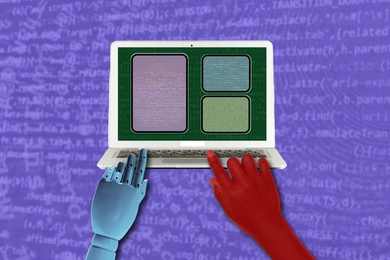Laboratories at MIT push boundaries beyond their primary research. Case in point: This year several labs signed on to reduce waste and hazardous materials and conserve energy and water.
It began on Earth Day, when MIT’s Environment, Health and Safety Office (EHS) awarded $5,000 in seed money to help labs create a culture of sustainability. Over the next several months, eight labs competed in the Green Labs contest.
Prizes included two $5000 awards, for the most resources saved and the most innovative solution. The winners — the Brushett Lab and the Wang Lab — were announced at a poster session in the Stata Center on Dec. 12.
Eyes on the prize
The Brushett Lab in the Department of Chemical Engineering (ChemE) won the award for the most resources saved. Aiming to become a net-zero-waste lab, its members managed to recycle almost all of their consumables, including gloves. They also adjusted equipment pumping speeds and gas pressure set points and reduced their use of electrolytes.
The Wang Lab in the Department of Mechanical Engineering won the award for the most innovative solution. They set up a complete energy monitoring test lab with WeMo switches and used it to determine which changes would save the most energy. They also plan to establish a Lab Energy Assessment Center, where MIT students in the Undergraduate Research Opportunities Program would be deployed to labs to monitor energy use and recommend changes.
The other labs that competed also did their part to make a difference:
- The Summons Lab in the Department of Earth, Atmospheric and Planetary Sciences reduced solvent use through new cleaning and rinsing practices and switched to less hazardous chemicals. They’ve shared their plastics recycling practices with other labs in their department.
- The Hamel Teaching Lab in ChemE will continue to teach students about energy and resource conservation and has a student conducting plug load monitoring of bioprocessing equipment.
- The Imperiali Lab in the Department of Biology reduced consumables and installed a Styrofoam container inside its dry ice chest, significantly reducing carbon emissions. This simple but effective change is now being implemented in other labs on campus.
- The Langer Lab in the Koch Institute piloted a shared workstation — with equipment and common materials in one place — to streamline purchasing and inventory audits. New researchers now receive recycling and energy management training as part of their orientation.
- The Prather Lab in ChemE warmed up freezers, improved water usage, helped start the department’s glove recycling program, and changed processes after monitoring equipment plug load.
- The Schuh Lab in the Department of Materials Science and Engineering installed low-flow aerators and worked with MIT Facilities to fix heating and ventilation issues. They also introduced training on green procedures.
Behind the scenes, MIT and the environment both benefited from the contest:
- Over a six-month period, the labs saved 40,000 gallons of water, 10,500 kWh of electricity, and 9,000 pounds of carbon dioxide.
- All of the labs received certification through an intensive assessment tool from My Green Lab.
- Students who learned about greening labs can encourage these practices when they move to other labs.
- Labs can share their conservation strategies with each other and with labs at other universities.
Next up: North American Freezer Challenge
EHS wants MIT to win the North American Freezer Challenge. The award will be given out in Boston next October to labs with the best energy-saving practices for cold storage. To compete, labs need to sign up by Jan. 15. To find out more, attend one of the IAP kickoff sessions on Jan. 9 or 11.
The Green Labs contest was sponsored by EHS, with support from Campus Construction, The Office of Sustainability, MIT Recycling, the Department of Chemical Engineering, the Koch Institute, and MIT.nano.
For more information about conservation efforts in MIT labs, browse the "Resources" tab at greenlab.mit.edu. You can also contact Pam Greenley or Niamh Kelly in EHS.







